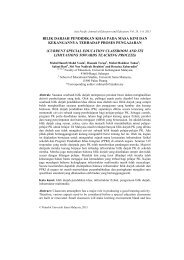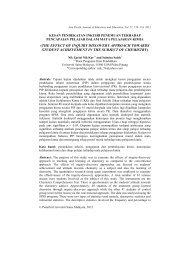Author template for journal articles - Asia Pacific Journal of ...
Author template for journal articles - Asia Pacific Journal of ...
Author template for journal articles - Asia Pacific Journal of ...
Create successful ePaper yourself
Turn your PDF publications into a flip-book with our unique Google optimized e-Paper software.
William Koh Siaw Yen and Ong Saw Lan<br />
Rasch can be generalised to polytomous items with ordered categories. This<br />
includes the partial credit model (PCM) (Masters, 1982) and the rating scale<br />
model (RSM) (Andrich, 1978), which can be expressed mathematically as:<br />
P<br />
x<br />
<br />
<br />
exp( ( B <br />
)<br />
j1<br />
xni <br />
ni k<br />
(exp ( B <br />
)<br />
k1 j1<br />
122<br />
n ij<br />
n ij<br />
The variable (δij) denotes the item step difficulty, Bn is the trait parameter <strong>of</strong><br />
person n and Pxni represents the probability <strong>of</strong> an endorsed response. In the<br />
model, the calibration processes involve comparing the amount <strong>of</strong> the trait (Bn)<br />
possessed by a person and the amount <strong>of</strong> the trait demanded by the item (δij).<br />
Generally, the higher the value <strong>of</strong> the item step difficulty (δij), the greater the<br />
difficulty level <strong>of</strong> a particular step relative to other steps within an item<br />
(Embretson & Reisse, 2000).<br />
RSM is actually a subset <strong>of</strong> PCM. In RSM, the step structure is restricted to the<br />
same structure <strong>for</strong> all items; thus, a common set <strong>of</strong> δ is estimated. This parameter<br />
δ is also known as the threshold (Andrich, 1978). Thus, RSM is only useful when<br />
distances between categories are equal <strong>for</strong> all items. In Rasch, item level<br />
difficulty is placed on a common metric parallel to the person's latent trait. This<br />
allows <strong>for</strong> comparisons between items and persons. The analysis was applied to<br />
determine whether the rating scale was used in the expected manner (e.g.,<br />
students with high academic achievement would be expected to use higher item<br />
ratings, whereas students with lower academic achievement would be expected to<br />
use lower item ratings). The Rasch measurement model provides a connection<br />
between a person's total score and the items <strong>of</strong> the instrument by placing the<br />
student's measure and item measure on the same linear continuum. Rasch is<br />
based on minimising the residuals between the predicted and observed location<br />
parameters <strong>of</strong> items (and persons) on a latent variable. Furthermore, by using<br />
Rasch analysis, which converts ordinal scale into interval-based measures (logodd<br />
metric or logit), the issue <strong>of</strong> scale metrics can be resolved. Item goodness <strong>of</strong><br />
fit statistics may be used to determine the extent to which each item fits the<br />
construct it will be used to measure. Hence, the fit statistics permit assessment <strong>of</strong><br />
the validity <strong>of</strong> the overall measure by providing a means to identify poorly<br />
functioning and/or biased items (Green & Frantom, 2002). Item fit can be<br />
interpreted as an index that reflects the convergence <strong>of</strong> the items to the construct<br />
being measured.<br />
Although there is no definitive rule <strong>for</strong> fit cut-<strong>of</strong>f values, some suggestions can be<br />
adopted, including the following:







